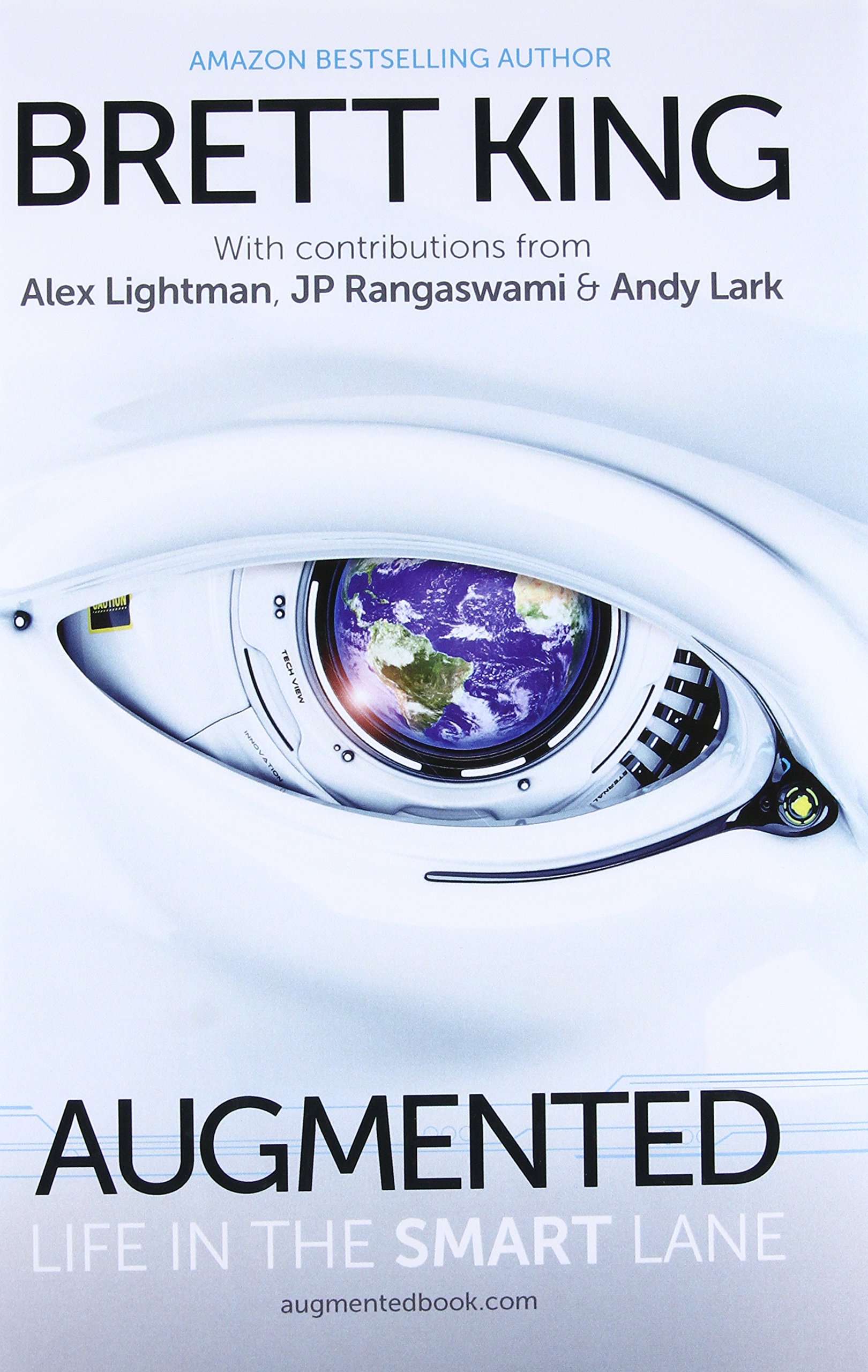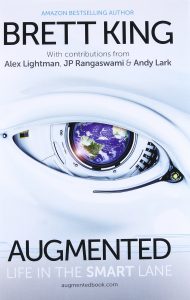Brett King – Augmented: Life In The Smart Lane
$995.00 Original price was: $995.00.$87.40Current price is: $87.40.
Is your bank ready to adapt? Chances are, you don’t have a choice. There is a promised level of disruption that Format File: [1 CD- 1MP3] File Size: 510.45 MB
Brett King – Augmented: Life In The Smart Lane
Description
Is your bank ready to adapt? Chances are, you don’t have a choice. There is a promised level of disruption that will come with Augmented Age – an age that will see more change in the next 20 years than in the last 250. Following on from the Industrial or Machine Age, the Space Age and the Digital Age, the Augmented Age will be based on four key disruptive themes – Artificial Intelligence, Experience Design, Smart Infrastructure and HealthTech. In this session, Brett King, best-selling author and radio host for Breaking Bank$, shares valuable insights into what lies ahead for all of us and a future vision of how these huge shifts in technology might impact your business and industry as both a disruptive force and area of significant opportunity.
Transcription
Brett King: Thanks for having me today. Yeah, I’m going to probably scare the crap out of you today I guess, but that’s my job. Especially after lunch because otherwise you’re just going to fall asleep, right? It’s great to be back in Austin. Have you guys ever been here for South by? If you come to Austin during South by Southwest it’s an absolute mad town. People everywhere. It’s crazy, but it’s nice to come here when it’s not so crazy, and you sort of get around town and be able to actually get into a restaurant for a change, right?
I want to talk to you today about the future and how there’s technology that’s going to change your business, but before we get to that I thought it is a very important milestone today. Do you know what today’s date is? Right, so what’s the thing about May 4th, right? May the 4th be with you, right. The first thing I wake up this morning is one of the fans of the radio show had done some fan art, and it looks like this, so I thought that was cute. When I talk about augmenting humanity with technology I’m not quite going this far with it, right?
I do want to talk to you guys about technology, and how technology is going to change the way we bank, the way we lend, and the context of financial services in our life. Now, the technology issue is that when we have technology that sort of infuses itself into our lives, as consumers we tend to get very excited about that, but the impacts of that in terms of business sometimes we’re less excited about the changes that represents. I mean, we’ll camp out for the latest iPhone or even Tesla Model three. When you saw the Tesla Model three was being advertised guys were camping out waiting to order their their Tesla Model three.
You don’t even see people camping out at their local branch to get a checkbook or a debit card or a new loan, right? Because we have very different products than what Apple or Tesla might have, so the context of that’s different, but as technology comes into our lives there’s sort of this ying and yang. You know, the ying is that we’ve got these exciting new gadgets. I’m sitting here. I see a Microsoft Surface tablet, an iPad, a couple of iPhones. I mean, the computing power sitting around this table right here … I don’t mean to pick on you guys, but if I just take those five or six devices you’ve got … There’s five of you, and there’s like seven devices on that table, but if you were to go back $1990 and take all of those devices that are on that table do you know what it would cost you to build a computer that had all of that technology built into it? Probably about $80 to $90 million to get the computing power that you guys have sitting on that table right now, all right?
Now, you carry around a smartphone in your pocket, and you probably don’t think of it in those terms, but if you were to compare the average iPhone 7 or a Samsung Galaxy S8, for example, to some of the early computers. For example, the computer that took Neal Armstrong and Buzz Aldrin and Michael Collins to the moon. The Apollo guidance computer. Your smartphone has three and a half million times the processing power of the computer that was in the Apollo 11 spacecraft, and what do we do with it? Well, we take selfies, we update our Facebook status, you know?
As this technology gets more and more involved in our lives we tend to treat it with this … It just becomes part of humanity, and yet we sometimes forget the negative effects that technology have on society. Now, if we go back 250 years … Actually, it’s closer to about 200 years ago. The height of technology disruption in 1812 was the steam machine, and it disrupted the number two industries, or the two top industries in the world at the time, being agriculture and textiles. Now, in the United States during the 1800s if you were in the U.S. during, say, 1850 through 1875 about 70% of the U.S. labor force was employed in farming back then, but in Britain the number one industry at the turn of the 19th century, 1800s, was textiles, and there was huge disruption at steam machines came into textiles because you can see up in the top left hand corner of this picture these leather belts that were connected to the steam machine, they made it so that a child could operate these steam machine based weaving looms to produce textiles. Prior to that you had to be a professional that apprenticed for five years to be able to use the manual weaving looms that were part of the textiles industry.
Get immediately download Brett King – Augmented: Life In The Smart Lane
If you think about the sort of displacement of professionals, leading industry of the time, the leading professionals that you had to train for four or five years to enter into that industry, and suddenly a machine comes along and takes your job away. That would be like today having a loan officer or a credit risk officer or an accountant losing their job to technology. That’s not going to happen, right? We’ve seen this before. For 200 years we’ve seen businesses have to cope with this technology shift. Now, in terms of agriculture this is what happened in the farming sector in the U.S. as a result of the introduction first of the steam machine and then the combustion engine. The red line is the number of people working on farms in the U.S., or the percentage of the U.S. labor force.
We went from 70% of the U.S. labor force in the mid 1800s down to 1.6% of the U.S. labor force today working in agriculture, so where did those jobs go? Did they just disappear? Well, thankfully no. They moved from one industry to another, so when the tractors came along and attacked farming jobs went out of agriculture and they went into building Model T Ford on the production line and other jobs like that, but when manufacturing had a downturn in the 70s in the U.S. where did those jobs go? We went out of blue collar factory work into service industries, and so more white collar jobs in the service industry and restaurants and human services around that.
Artificial intelligence is going to impact those industries potentially, so let me take quickly about the big disruptive things of the next 20 or 30 years as a futurist in terms of what we see coming down the pipe that’s going to change the way we work and the way we live most significantly. We’ll start with AI. AI is obviously the big one. Now, when you think about artificial intelligence what do you guys think of? Do you think of the T-1000? You know, Arnold Schwarzenegger? You know, the Terminator? Do you think of Siri that’s built into your smartphone today? There’s a big gap between how Hollywood pitches artificial intelligence and what we’ve actually got today, so if you think about the stages of AI in terms of it’s development we might start with something like today where we have task specific AI, or machine intelligence that does a specific job.
I’m going to show you one of the best examples of robotics and AI today in a moment that’s very popular in the U.S., but probably one of the most common form of artificial intelligence that we’ll see in the near term would be, say, a self driving car. Like a Tesla with autopilot. Does anyone have a Tesla? All right. Not yet. Okay. That’s not an issue necessarily. You don’t have to have a Tesla to be here. We talk about three developmental stages of artificial intelligence, so we have task specific machine intelligence today. The next step is artificial general intelligence. This is where an AI or a computer can trick you into thinking it’s a human. Can pass the Turing test. Then the next level is what we call strong AI. This is when you have AIs that are smarter than humans. Now, we’re probably 30 to 40 years away from that, but in terms of artificial general intelligence, having an artificial intelligence built into your phone or your home that you can converse with, we’re not as far away from that, and these smart assistants are going to be very, very big business over the next 10 years.
It’s going to be interesting how that changes the way we live when you can just ask your phone to book you a restaurant or book you a flight to Seattle for the weekend or something like that. Though I don’t know why you’d want to go to Seattle particularly, but that’s for the benefit of JP Nichols who’s here who’s from Seattle, by the way. Okay, so AI is going to be a big disrupter. It’s going to change the way we work significantly. About 45% of jobs in the United States today could be subject to displacement as a result of AI. We saw this with the steam engine. We saw it with the internet. We saw it with the production line in manufacturing. We’ve seen this displacement of employees over and over again, so is it necessarily something to be concerned about? For every job that the internet destroyed, quote unquote, 2.6 new jobs were created by the internet, so there’s a school of thought that this is not such a bad thing, but futurists are divided on whether AI is going to create net new jobs, or going to create net loss of jobs, and the more we learn about AI the more likelihood that it’s going to create higher levels of unemployment in developed economies. Even more so in an economy like china due to their structure. AI is a big disruptive thing.
The second is embedded technology experiences. If you think about this, every we do in the future will be through a technology lens. If you’re a service business the majority, the vast majority, if not all of your business will come through a technology layer. It one involve human interaction at all unless it’s very, very specialized. The sort of technologies that will embed these experiences in the world around us will be senses, the innative things, those data points that inform algorithms to make decisions.
Augmented reality or mixed reality glasses that we’ll be wearing. This time next decade you’ll probably be wearing a set of glasses that will replace your iPhone, and your glasses will give you data in your head up to space. Sounds like science fiction, but there are many many companies spending billions of dollars on this right now, and if you look at Facebook’s plan for the next 10 years it’s really centered entirely around mixed reality glasses. Not just that, in our home, in the workplace, in the world around us we’ll have intelligence built in to the world around us. Whether it is a smart screen built into the wall of our home or our smart assistants that can listen to us and react to us, or a bathroom that’s smart enough to tell you that you’re not well by analyzing your stuff, you know?
The whole world around us will have intelligence, and your business will have to integrate into this otherwise you become irrelevant because you can’t deliver stuff in a smart way, so you have smart companies versus dumb companies in the future, and the difference is purely leveraging off this technology layer. Health tech is probably going to be impacted even more. Like the health industry is going to be impacted even more than financial services. Today right now of course there’s a lot of controversy today about this new healthcare bill that’s passing or potentially going to pass in congress, and yet what’s really interesting about this is the technology changes that are going to occur in healthcare completely undermine the way we’ve argued the factor of universal healthcare in the United States being a large government program.
When you can deliver through technology healthcare at a fraction of the cost of what we do today then it’s likely that in ten years time a political movement to stop universal healthcare will be more expensive than actually providing universal healthcare, so this is going to take a mind shift philosophically for governments like the United States government and others who see this as socialism. Gene editing is one area, so we now can extract …Thanks to all this computing power that we have we can take your DNA out, and we can sequence your DNA, and we can reprogram that DNA and inject it back into your body using a viral vector, so diseases like Parkinson’s, Alzheimer’s, hereditary heart disease, hemochromatosis, cystic fibrosis, these are all genetic diseases, breast cancer, we’ll just edit it out of the software. It’s like a software bug in our DNA. We can just edit it out in the future, and fix it that way. You won’t treat these diseases, we’ll remove these diseases from our DNA.
Now there are ethical considerations for sure, but imagine the changes in how that will impact the pharmaceutical business in terms of their regime of treatment of symptoms and so forth. It’s just incredible to think about. Wearing a wristwatch with a censor in it that can predict a heart attack. You know, if you live in California or New York the cost of a cardiac event, having a heart attack, $90,000 if you don’t have health insurance. What if I can give you a $20 censor that you wear on your clothes or on your wrist that combined with an AI can predict that you’re going to have a heart attack maybe three or six or nine months out, and we avoid the cost of a heart attack altogether? Now you start to see the implications of technology on healthcare as a cost. It’s a very interesting world.
Now, you combine all of this. You combine AI, you combine embedded technology experiences, the change we’re seeing in financial services and healthcare, and what you see emerge is smart cities, smart infrastructure, smart economies. Economies that are differentiated on their ability to deliver technology, deliver businesses on that technology layer. This is how companies are going to be differentiated in the future. Not by the way they’ve traditionally done business, but by the way they leverage this technology to be smart and embed themselves in their customer’s lives.
The biggest shift for you guys is that your customers won’t come to you in the future. You will be embedded in their life when and where they need it. If you’re not, you’re not relevant. If you have to wait for a customer to come to you and then sign a piece of paper to get access to the services you have you’re out of business. You just don’t know it yet. This is the difference, all right? You’re either going to be a smart company on this layer, or you’re going to be an old company that does things the old way, and sure there’s going to be some customers that still like doing that for a while, but ultimately the whole world is sort of being pushed by this wave of technology change that we’ve seen, and this is not new. We’ve seen it for 250 years. Over those 250 years when you look at companies and industries that have faced this sort of technology shift, how many of those industries have survived with their business model in tact when technology disruption has come knocking? None of them. Maybe with the exception of government. Although that’s being pretty disrupted right now, right? Okay.
You know, if you look at the way we think about this we have to start thinking about the way we build our businesses quite differently. If you look at solar, solar is an interesting philosophical argument in the U.S. right now about subsidized solar energy and things like that, and whether or not solar is as cheap as everyone’s saying it’s going to be, but if you think about the problem in the U.S. it’s actually not climate change. The biggest problem we have in the U.S. that our electricity grid has 130 million wooden poles to deliver electricity. This is not a smart system. Whereas solar allows us to build this distributed layer of generation technology at a much cheaper basis, and the energy that we’ll be generating or the cost of generating solar will be 1/10 of the price of coal generated electricity within a decade, so actually it doesn’t matter whether you believe in climate change or not. If you don’t the vest in solar as an economy in 10 years time you’ll be paying 10 times what china is paying for electricity, and the U.S. economy cannot remain competitive on that basis.
Solar is not like coal. The only way you can make coal cheaper is to find more efficient ways of pulling it out of the ground. Whereas with solar, solar is subject to the same principals that we see in the iPad and the iPhone you’ve got in your desk there. It’s subject to Mars law, so every couple of years the technology in solar is improving and the price reduces by half. This is why within just ten years no fossil fuel will be as competitive as renewables that are based on these technologies.
Trump. You knew that was coming, right? Now, in the lead up to the U.S. elections this is what Trump said about Apple and how we deal with the job situation in the United States.
Donald T.: We’re going to get Apple to start building their damn computers and things in this country instead of in other countries.
Brett K.: Now, this is a fairly predictable reaction, and we see this occurring even in the French election right now. We see these sorts of discussions. You know, I have a sort of saying about this that if you don’t like immigrants taking your jobs you’re probably going to like robots taking them even less, but hear the problem with this statement that Trump made is the largest supplier to Apple right now which is Foxconn in China. They produce more Apple devices than anyone else in the world. Foxconn is replacing 6,000 humans a week with robots at this point. Now, if Apple was to move the manufacturing facilities back to the United States do you think they would put humans on the production line? There’s no way they could afford to do that. They’d have to build a robotic factory. Tesla’s doing that in Nevada of course, and others are following suit.
Apple may very well come back to the United States, but it would be on that basis, so unless you’re a robot engineer or a robot installer or repair person then you’re probably not going to see the immediate effects of Apple bringing their factories back to the United States in terms of job creation. We have to start thinking about this in terms of building smart economies. The obvious question is where can we differentiate against humans? How do companies in the future, particularly in the financial services space, remain relevant?
This is Ava from the movie Ex Machina. I don’t know whether you saw that movie. It was a depiction of an artificial intelligence. Now, I will point out at this stage that Hollywood is not a scientific research body, all right? When they depict artificial intelligence this is actually not what AI looked like today. This is what AI looks like today. This is a self driving vacuum cleaner. I don’t know if any of you guys have this. Have any of you guys got an iRobot, a Roomba? Oh, there’s a few. Right. 20% of all vacuum cleaners sold in the world now are robots, so this is pretty cool. Now, yeah you can find some very interesting funny memes about these vacuum cleaners on the internet. I won’t say anymore than that, but the robots that actually we’ll see involved in our life don’t necessarily have to look like humans to have impact in terms of the way we’re going to go about our business.
In fact, these are the sort of robots soon to be commonplace over the next decade that we’re going to see increasingly involved in our societies. Robots that deliver goods and services, robots that deliver pizza, you know drones and so forth. Now, what’s really interesting about this is we never saw drones coming. We never saw robots in this form sort of coming when we look back at science fiction 50 years ago. We didn’t think of robots that delivered your pizza via air as an example, but 80% of Amazon’s product that is delivered is under five pounds and could fit on a drone, so this is why Amazon is investing this.
You know, when Amazon announced Prime Air, they announced it on April the 1st a couple of years ago, and everyone thought it was an April fools joke. It’s not, you know? Now, by 2035 there’s actually going to be more robots on the planet than humans. There’s going to be about 10 billion robots by the middle of the 2030s, so my only suggestion to you is if you want to make a safe bet just be kind to robots. You just never know what’s going to happen in the future, okay?
Now, when we think about artificial intelligence there’s unwritten sort of philosophy within financial services that a human’s always going to want to go to another human to get advice, so the real question is, is the advice that we get from a human going to be better than an advice that we’ll get from a machine in the future or from an algorithm? That’s the question. I want to illustrate the problem this way. This is what a self driving car sees through it’s lidar rig. This is a light emitting radar technology. Now, these lidar rigs you’ve probably seen photos of these self driving cars with these rigs on the top of the cars. They can capture 1,000 times more information than your human eye can see. 1,000 times more information. If you’re driving a car you can’t see out the back of your head, all right? Despite what my ex wife claims about her ability to see out the back of her head
We can’t see 360 degrees, but a lidar rig can, and it can process that information in a fraction of the time that we take to make the same assessment of whether there’s a risk or not, so the current technology we have with the self driving rigs, it can process information 70% faster than your brain in terms of making an assessment whether I should put the brakes on to avoid an accident, and it can anticipate that much earlier because it can see a lot more than you can. Statistically speaking despite the fact that some of us may have reservations about getting into a self driving car, once this technology is mature no human will be able to drive as safe as a computer with an antonymous driving algorithm. That’s because it can just process a lot more data to make a decision.
This sort of exists in terms of information asymmetry in financial services we’ve always maintained that a wealth manager or a private banker or a loan specialist that’s dealing with a big corporate knows something that you as a client don’t know, and that information asymmetry is why you go to advisor, but what happens when a machine has information asymmetry over the advisor? When it can process more information than any human on the planet can? When it can look at trends that we can’t understand? The real advice that’s going to be really interesting in terms of financial services though is not the advice we typically think of as we think about advice in financial services.
Now, when you think about advice in financial services today, if I go to a retail bank, and I’m looking for advice on a mortgage do I get advice on how to save for a home? No. I get advice on whether it’s this mortgage or that mortgage is the right product for me. If I go in to meet a wealth manager what sort of advice do I get? Well, I don’t get advice on creating wealth as a sort of overarching strategy necessarily unless you get maybe a financial coach or something like that. Typically I’ll get advice on whether this asset class or that asset class is the right investment strategy for me. I tend to get advice that’s very closely aligned with the product offerings the financial institution has. The advice that we’re going to find most common that is going to be AI based in the future will just be advice that’s based around you and your financial behavior.
Get immediately download Brett King – Augmented: Life In The Smart Lane
For example, hey Siri, can I afford to go out for dinner tonight? That’s a question that your smart assistant AI will be able to answer in short order. There’s already companies who can do this recognize now based off aggregated financial data such as Clink that was born out of Silicon Valley here in the U.S., so this is the sort of advice that we’re actually going to have integrated into our daily life. Maybe it will be more in terms of cash flow of my company. When should I be taking credit to boost up my stock for Christmas? These sort of questions your AI will be built into your life, into your business, and be able to answer to help you manage your day to day financial wealth and health.
AI advice that we sort of see embedded in the world around us may be different from the sort of advice that we’re used to having. Now, what we see is that AIs are developing the ability to really suck up huge amounts of data and use that to give us advice back that is in many ways better from a diagnosis point of view. IBM Watson’s been involved in the cancer research and cancer diagnosis space is now 96% accurate at predicting or at diagnosing the type of cancer that you might have. You might go into your family doctor, and your family doctor says, “I’m a bit concerned about this. Let’s get some blood work. Let’s take a biopsy or whatever because you, you know, we want to get on top of this. Make sure you don’t have cancer.”
Now, in those scenarios in the United States statistically when you see a cancer specialist he will get the diagnosis right 50% of the time. That’s why you always ask for a second opinion, but Watson gets it right 96% of the time because Watson can suck up 25 years of medical journals, all of the blood work, all the analysis, all the latest research data, genetic tests, and it can suck all of that information up and in a split second make a diagnosis. Even if the oncologist that you went to has had access to those 25 years of research what’s the likelihood he remembers every single article ever written about your type of cancer? It’s just not possible. That’s why Watson’s better at diagnosing cancer than a human. Now that you know that information if your family doctor thought maybe you had cancer would you absolutely insist on getting advice from a human doctor versus a doctor that has access to Watson? This is the same challenge we’re going to face in the financial services space.
The financial advisors that differentiate are going to be those that have access to these platforms. Not those who have experience. Experience is not going to get you there. The ability to analyze data is. Now, AIs have the ability to surprise us and think differently, and this is also going to be another benefit that organization have in this technology, so this is a representation of Google’s translation algorithm or machine learning capability where it can suck in all of these different languages and translate between two disparate languages. Now, what the engineers found is that Google’s machine learning algorithm came up with it’s own language to do this. Not something they programmed. It came up spontaneously with it’s own language. The Google engineers called it an interlingua. A language in between others. If you’re looking at Farsi and Korean for example it would be able to translate those two languages even though a Farsi Korean dictionary doesn’t exist using this algorithm.
AIs are going to start to create ways of analyzing data and spitting out advice that even the engineers who build those AIs aren’t necessarily going to understand. It doesn’t make it wrong, but it means that AIs will at a certain point in the future exceed our ability to understand how they get to that advice. Will we trust the machines in that instance? That’s going to be part of the interesting path we have to go through. Now, this is a self driving race car that Audi built as a test rig. They have two of these vehicles. Test vehicle A and test vehicle B that Audi called them. Actually they gave them nicknames, the engineers. AJ and Bobby were what they nicknamed these two vehicles.
Now, exactly the same vehicles. Same spec in terms of the car. Same hardware, same firmware, same software, and yet Bobby drives faster lap times. Drives more aggressively than AJ, so I asked the engineers at Audi, why is that? Why does Bobby consistently get faster lap times than AJ when they’ve got exactly the same hardware, the same software, all of that? The Audi engineer that I spoke to he said, “Yeah, um, we don’t know, but we think early in the cycle that one of the engineers that was training the vehicle to drive around the track, maybe he drove a little bit more aggressively one day than he did the other day on AJ, and that set the tone for the way this AI learned to drive. It learned to drive more aggressively.
Even though we might have this artificial intelligence we’re going to see different AIs have different personality and give us different advice based on the way they’ve learned and which data they’ve put into the system. Sounds very human, doesn’t it? How do we as a species compete with AIs in the future? You know, you’ve heard about this threat that AIs are going to take all these jobs away from us, and we might have robot overlords take over the world, so how do we change this? Well, people like Elon Musk thinks we’ll have to augment our own intelligence with AI, so this is not AI this is IA, intelligence augmentation. Elon Musk has actually started a company recently where they’re developing a neural lace which is an integrated cognitive computing capability that you’ll connect directly into your brain, and you’ll have access to computing power.
Ray Kurzweil is another one that says this is the only way that humans are going to have to be relevant in the short term in terms of being able to compete with machines. Now, you might think that this sounds like science fiction, but if I was to ask you what year Isaac Newton was born how would you answer me that question today? You’d Google it, so we’ve already augmented our intelligence today with the Google, right? My kids wouldn’t even know what an encyclopedia looked like. Google’s the answer to all their stuff, so if we could have the capability of answering those questions, for example, just by doing a Google search in our head would we elect to use that technology ourselves?
Well, to keep pace with AI and it’s impact in the world some believe that’s the only way we’re going to be able to do it. That’s the only way we’re going to be able to compete with these changes in society. Now, we are already using some of this technology. In financial services we’re now using algorithms to identify customers such as facial recognition. Now, if any of you guys have been into come into the U.S. through JFK or LAX or San Francisco or Chicago O’Hare airports recently, you probably came through customs and border protection where you used biometric identification systems, right? They have hand prints, facial recognition now.
In Europe it’s facial recognition is more popular. In Asia it’s a mix between fingerprint or hand print or facial recognition that’s being used, by why do U.S. customs and boarder patrol officials use facial recognition or hand print recognition to identify you at the border now as an American citizen? Well, the truth is it’s 20 times better than the eye of a customs officer in identifying you. 20 times more accurate
Course Features
-
Lectures
0 -
Quizzes
0 -
Duration
Lifetime access -
Skill level
All levels -
Students
133 -
Assessments
Yes
Be the first to review “Brett King – Augmented: Life In The Smart Lane” Cancel reply
Related products
Other Courses
Other Courses
Other Courses
Other Courses
Other Courses













Reviews
There are no reviews yet.